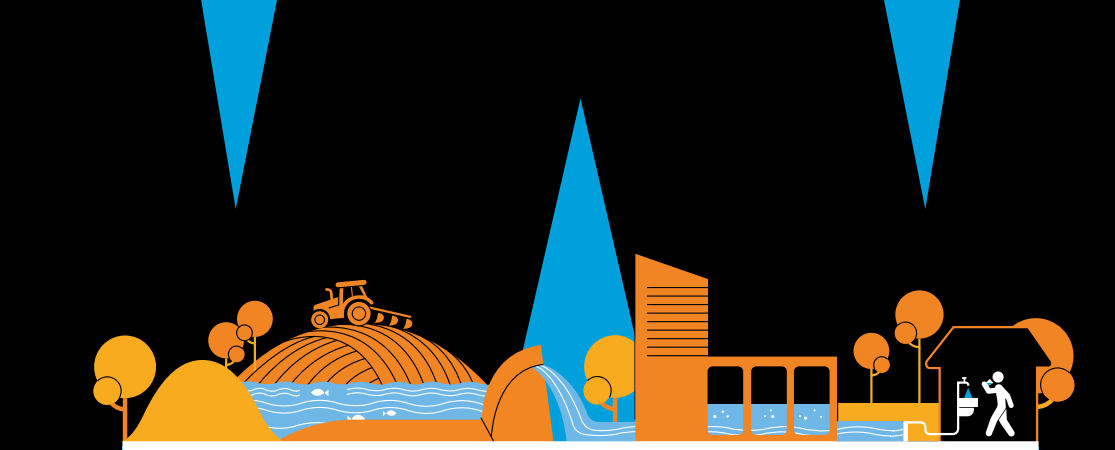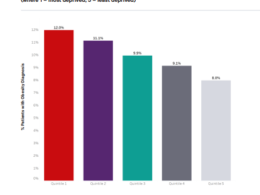WHO
October 24, 2022
Site Editor:
Joaquim Cardoso MSc.
health transformation — center of excellence
October 24, 2022
Universal access to safe drinking water requires increased investment backed by strong government institutions — WHO, UNICEF, World Bank
Governments must invest strategically in building safe drinking water systems by not only increasing funding, but also strengthening capacities to plan, coordinate, and regulate service provision, …
… if the world is to achieve universal access to safe drinking water and mitigate the effects of climate change, say WHO, UNICEF, and the World Bank in a report released today.
The State of the World’s Drinking Water report notes that over 2 billion people have gained access to safe drinking water in the past two decades.
This progress, while positive, is fragile and inequitable with one-quarter of the world’s population left behind.
Climate change is increasing the frequency and intensity of droughts and floods, which exacerbate water insecurity, disrupt supplies and devastate communities.
Meanwhile rapid urbanization is increasing the strain on cities’ capacity to deliver water to the millions of people living in in-formal communities and slums.
Climate change is increasing the frequency and intensity of droughts and floods, which exacerbate water insecurity, disrupt supplies and devastate communities.
Meanwhile rapid urbanization is increasing the strain on cities’ capacity to deliver water to the millions of people living in in-formal communities and slums.
“Providing greater access to safe drinking water has saved many lives, most of them children. But climate change is eating into those achievements,” said Dr Maria Neira, WHO Director, Department of Environment, Climate Change and Health.
“We have to accelerate our efforts to ensure every person has reliable access to safe drinking water something that is a human right, not a luxury.”
“Providing greater access to safe drinking water has saved many lives, most of them children. But climate change is eating into those achievements,”
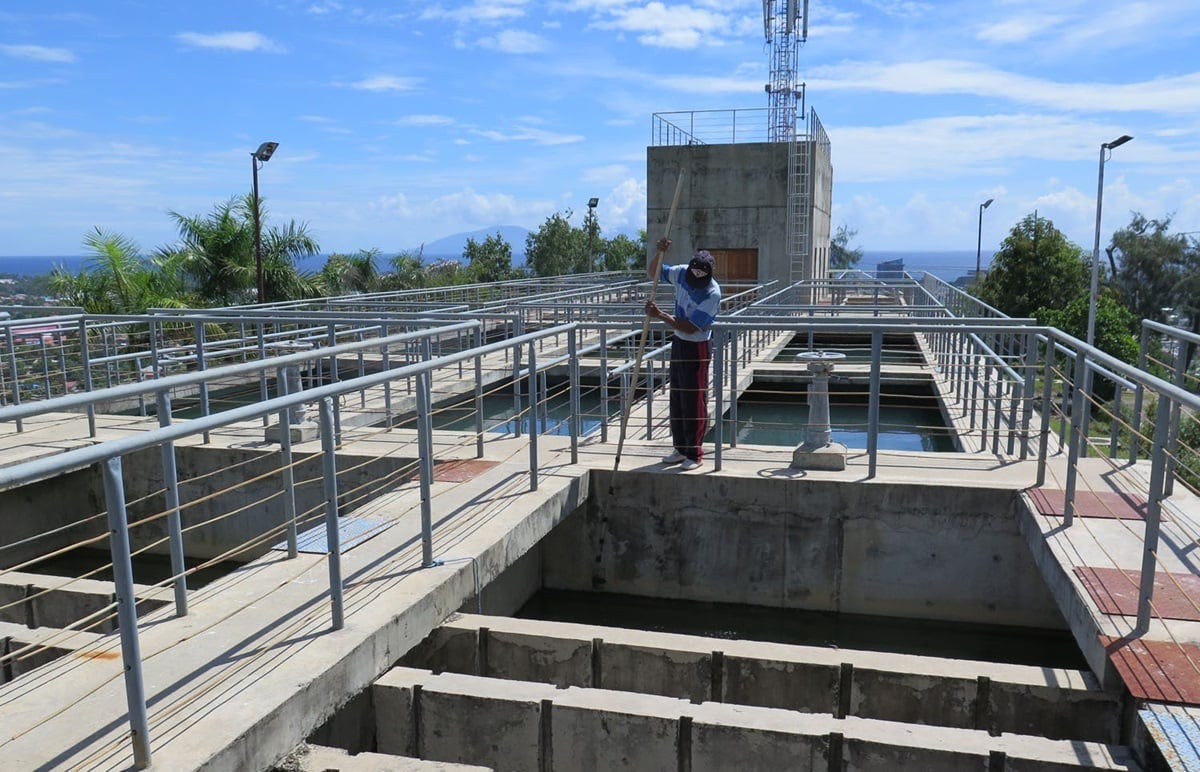
The report provides a comprehensive review of the links between water, health, and development, with actionable recommendations for governments and partners, illustrated by examples of how countries are contributing to the attainment of the Sustainable Development Goal (SDG) target of reaching safely managed drinking water for all by 2030.
“Investing in water and sanitation is critical to health, economic growth and the environment. Healthier children become healthier adults who then contribute more to the economy and society”, said Saroj Kumar Jha, Director, Global Director, World Bank Group’s Water Global Practice.
“This principle is at the core of the World Bank’s Human Capital Project.
Governments and private sector must take critical action now to accelerate inclusive and sustainable water supply and sanitation services in both urban and rural areas.”

To provide universal access to safe drinking water by 2030, governments and partners must dramatically increase political commitment to drinking water and quadruple investments.
The report provides comprehensive recommendations to enact sustainable improvements that addresses infrastructure, governance, finance, capacity development, data and information, and innovation, even with limited budgets.
Overarching recommendations include:
- Strengthen existing institutions by filling gaps, facilitating coordination, establishing a regulatory environment supported by legislation and standards for service quality, and ensuring enforcement.
- Increase funding from all sources dramatically, with water service providers improving efficiency and performance, and governments providing a stable and transparent administrative, regulatory and policy environment.
- Build capacity within the water sector by developing a capable and motivated workforce through a range of capacity-development approaches based on innovation and collaboration.
- Ensure relevant data and information are available to better understand inequalities in drinking water services and make evidence-based decisions.
- Encourage innovation and experimentation through supportive government policy and regulation, accompanied by rigorous monitoring and evaluation.
“No child should be faced with the choice of drinking dirty water — a leading killer of children — or making dangerous journeys to collect water and missing out on school,” said Aidan Cronin, UNICEF Interim Director of Water, Sanitation, and Hygiene (WASH) and Climate, Environment, Energy, and Disaster Risk Reduction (CEED).
“Accessible and reliable safe drinking water is fundamental to ensuring children are healthy, educated, and thriving.”
Originally published at https://www.who.int on October 24, 2022.
Infographic
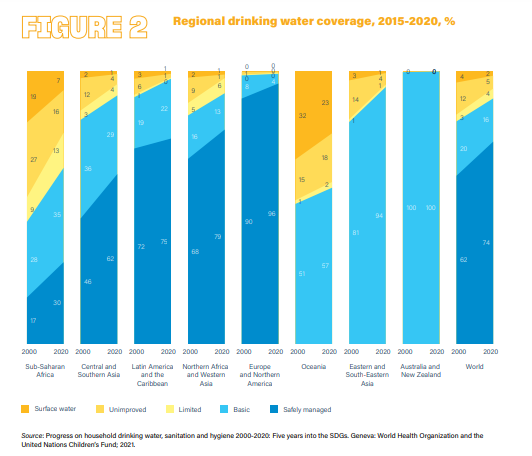
Reference publication

Foreword
Every day, millions of women and school-age children — almost always girls — spend hours walking long distances to fetch water, which may be of poor quality, limited quantity or unaffordable.
For hundreds of years, efforts to improve the delivery of safe drinking water have led to gains in public health and huge reductions in child mortality.
In the last two decades, two billion people gained access to safe drinking water.
The returns on investment for health, productivity and other factors are estimated at more than three times the cost in urban areas, and more than six times the cost in rural areas.
In the last two decades, two billion people gained access to safe drinking water. The returns on investment for health, productivity and other factors are estimated at more than three times the cost in urban areas, and more than six times the cost in rural areas.
So why do we need another report urging action?
1.The first reason is that we face a crisis.
Our understanding of the benefits of safe drinking water and the progress we have made, an estimated two billion people, one quarter of the world’s population, still go without.
Unsafe drinking water is a driving factor behind the more than 1.5 million people who die every year from diarrhoea, most of them infants and small children.
Every one of these preventable deaths is a tragedy.
Meeting the Sustainable Development Goal target of universal access to safe drinking water by 2030 will require countries and multilateral organizations to quadruple their investment — a small price to pay for the millions of lives saved.
2.The second reason is that the progress we have made on increasing access to drinking water is fragile.
Safe water is not a one-time investment. It requires monitoring and upkeep.
At the same time, external factors threaten to roll back the gains we have made.
- Climate change is driving water scarcity and droughts, while flooding disrupts supplies and devastates communities.
- Pollutants threaten both human health and entire ecosystems.
- Urbanization and population growth are limiting the ability of cities to deliver water to the millions of people living in informal communities and slums, while in rural areas, low quality services, waterpoint breakdown, and distant, contaminated water sources are a daily reality.
At the same time, external factors threaten to roll back the gains we have made.
3.The third reason is that there is an opportunity.
In 2023, for the first time in 50 years, the global community — through the United Nations — will review progress and make firm commitments to renew action on water.
We must leverage this moment to catalyse new action.
This report is the first of its kind: a comprehensive survey of the links between water, health and development, with actionable recommendations.
This report is the first of its kind: a comprehensive survey of the links between water, health and development, with actionable recommendations.
We hope that it will inform preparations for the 2023 review and catalyze follow-up action in the second half of the SDG period.
We call on governments and development partners to dramatically increase investment to extend access to safely managed drinking water services to all by 2030, beginning with the most vulnerable.
Our organizations remain committed to supporting countries to provide safe drinking water for all.
We call on governments and development partners to dramatically increase investment to extend access to safely managed drinking water services to all by 2030, beginning with the most vulnerable.

Executive Summary:
The first target under Sustainable Development Goal (SDG) 6, Target 6.1, is, “By 2030, achieve universal and equitable access to safe and affordable drinking water for all”.
- In the last two decades investment in drinking water services has led to considerable increases in access.
- Two billion people globally gained access to safely managed drinking water services.
- In 2020, 74% of the world’s population used safely managed drinking water, up from 62% in 2000.
- Despite this progress, there are wide geographical disparities, and 2 billion people still do not use safely managed drinking water.
The world is not even close to being on track to meet the SDGs by 2030.
Continued progress on SDG Target 6.1, and the additional acceleration needed to achieve universal access, is threatened by the ever-increasing impacts and uncertainty of climate change, competing agricultural and ecological water needs, competing financial priorities and the challenges of existing and emerging threats to water quality.
Continued progress on SDG Target 6.1, and the additional acceleration needed to achieve universal access, is threatened by …
… the ever-increasing impacts and uncertainty of climate change, competing agricultural and ecological water needs, competing financial priorities and the challenges of existing and emerging threats to water quality.
This report presents the state of drinking water in the world today, the progress being made towards achieving SDG Target 6.1, and the challenges that remain.
The SDG 6 Global Acceleration Framework calls on governments to make progress on governance, financing, capacity development, data and information and innovation.
Using this framework, recommendations are presented, illustrated by examples of how countries have addressed the challenge of providing safely managed drinking water.
As a service that provides immeasurable economic and health benefits, and essential gender equality outcomes, the need to dramatically increase political commitment to drinking water is clear, …
… as is the need to strengthen governance and institutions and significantly increase the financial resources available. Drinking water services must reach everyone, including the poor, vulnerable and marginalized, consistent with the promise to leave no one behind.
This report includes a comprehensive set of recommendations structured around governance, financing, capacity development, data and information and innovation.
The list of potential actions is wide-ranging and some changes will take sustained action by multiple stakeholders over many years. However, there are many ways in which committed governments can make significant steps to start the process, even with limited budgets and while capacity is developing.
- 1.Overarching recommendation on GOVERNANCE
- 2.Overarching recommendation on FINANCING
- 3.Overarching recommendation on CAPACITY DEVELOPMENT
- 4.Overarching recommendation on DATA AND INFORMATION
- 5.Overarching recommendation on INNOVATION
1.Overarching recommendation on GOVERNANCE
Governments should progressively strengthen existing institutions, fill institutional gaps and facilitate coordination. They should establish a stable regulatory environment supported by legislation and clear policies, including standards for service quality, and ensure enforcement.
- Governments should establish simple and transparent regulation that protects all consumers, allows and encourages continuous improvement, innovation and cost recovery, and facilitates service provision for the poor and vulnerable, consistent with the commitment to “leave no one behind”.
- Regulators must be as independent as possible, have authority for and conduct enforcement, and be mandated to publish results.
- Governments should create an enabling policy environment that supports higher service levels in households, health care facilities and schools, so that safe, abundant, on-premises drinking water becomes the norm.
- Government policy should support improvement in the operational performance of service providers, and the establishment of management models that ensure sustainable, professionalized service delivery in both large and small systems.
- Drinking water quality should be regulated using risk-based approaches, for instance, through water safety plans undertaken by service providers and supported by surveillance.
- Governments should consider the impact of climate change and take action to increase the resilience of water infrastructure and services, and mitigate their climate impact.
- Governments should promote coordination between mandate-holders in the water sector, and encourage collaboration across drinking water service provision and water resources management, between rural and urban authorities, and across ministries.
- Governments should review policies, regulatory arrangements, strategies and implementation models to ensure they are inclusive and gender sensitive.
2.Overarching recommendation on FINANCING
To achieve the quadrupling of progress needed, funding and financing from the public sector, private sector and donors must increase dramatically, water service providers must improve efficiency and performance to ensure funds are used optimally, and governments should provide a stable and transparent administrative, regulatory and policy environment that encourages investment.
- Governments should develop clear policy objectives to guide funding and financing decisions, fully understand all the costs of drinking water service provision, and make informed, evidence-based decisions on the allocation of funds and the setting of tariffs and user charges.
- Governments should invest in drinking water services, using allocations from the public sector budget catalytically and strategically, creating incentives for efficient, sustainable service provision and prioritizing reaching the unserved.
- Governments should encourage and support improvements in water service providers’ financial performance.
- Governments should ensure they achieve an appropriate balance between investing in new infrastructure and supporting the maintenance of existing infrastructure.
- Governments should budget for the costs associated with a supportive regulatory environment.
- Governments should seek to establish a conducive environment for the use of commercial repayable finance, both domestic and international, bearing in mind the complexities and the time and expertise involved. Governments should also develop the expertise and understanding to comply with the requirements of climate finance and access it.
- Governments should work with agencies and institutions that support and provide microfinance to households for water supply investments.
3.Overarching recommendation on CAPACITY DEVELOPMENT
Governments should build robust and competent institutions and a capable and motivated workforce through a range of capacity-development approaches based on innovation, partnership and collaboration.
- Capacity should be built in technical areas specific to water supply services and also to create a conducive enabling environment for sustainable water supply services, including competence in long-term planning and budgeting, improved cost recovery, revenue generation and financial sustainability.
- The growth of professionalized service delivery must be supported by capacity development, particularly in small and rural systems.
- Governments should seek to build their own capacity, and that of partners in the sector, by establishing fully institutionalized training programmes.
- Governments should strengthen their capacity to integrate climate resilience and mitigation into planning, designing and delivering drinking water services, including protection of source water. Capacity should be built among regulatory agencies, service providers and users to ensure they have the knowledge and instruments to address climate change impacts.
- Governments should foster inclusion in the sector, and seek to achieve gender, ethnic and cultural balance among the staff of sector institutions.
4.Overarching recommendation on DATA AND INFORMATION
Governments should ensure they have relevant data and information to be better informed, understand gaps and inequalities in drinking water services, and make evidence-based decisions.
- Governments should support the institutionalization of data collection and monitoring within national systems and at all levels (community, utilities, subnational and national), the use of consistent methodologies, including standardized terms and questions, and the use of the data collected.
- Governments should identify gaps in data collection and analysis, and prioritize those areas in which missing data are a constraint, with particular emphasis on the identification of communities and individuals at risk of being left behind in service provision.
- Governments and other stakeholders should encourage and fund research in the water sector, work with academic institutions, and disseminate results to inform decision-making.
- Disseminating data on service provider performance should be prioritized by governments to drive improvements and promote accountability to users.
5.Overarching recommendation on INNOVATION
Governments should encourage innovation and experimentation through supportive government policy and regulation, accompanied by rigorous monitoring and evaluation.
- Governments should create a policy vision and foster the political leadership required to identify innovative approaches and bring them to scale.
- Governments should create a flexible regulatory environment to encourage innovation, and regulations should be regularly updated to reflect changes in the evidence base and the availability of better technologies.
- Innovation should be encouraged in methodologies and approaches, as well as in technologies.
As highlighted in this report, there are key opportunities in the years up to 2030 to strengthen government leadership, show political will, deepen partnerships and make strategic and catalytic public investments in drinking water. Governments have many opportunities to advance progress on the provision of reliable, safe and sustainable drinking water services, and working across all the SDG 6 accelerators will result in sustainable results and greater impact. Member States, the United Nations system, and other sector stakeholders must rise to the challenge, learn from one another and work together to achieve universal and equitable access to safe and affordable drinking water for all by 2030.

Looking ahead: A pathway to 2030
There are key opportunities in the years up to 2030 to strengthen government leadership, show political will, deepen partnerships and make strategic and catalytic public investments in drinking water. This will be necessary to achieve the acceleration in progress required to achieve safely managed drinking water for all. As can be seen from Figure 22, on average, a quadrupling of progress is needed to meet SDG Target 6.1.
As this report has shown, governments have many opportunities to make progress on the provision of reliable, safe and sustainable drinking water services. Working across all the SDG 6 accelerators will result in sustainable results and greater impact. As a service that provides immeasurable economic and health benefits, and essential gender equality outcomes, the need to dramatically increase political commitment to drinking water is clear, as is the need to strengthen governance and institutions and significantly increase the financial resources available. Given the complexity of sustaining safe drinking water supply, efficient, professionalized management of water supply is needed, including in rural areas. Environmental and climate issues must be integrated into drinking water planning and risk management to ensure resilience, adaptation and sustainability of drinking water services. Finally, drinking water services need to reach everyone, including the poor, vulnerable and marginalized, consistent with the promise to leave no one behind.
The list of potential actions presented in this report is comprehensive, and some changes will take sustained action by multiple stakeholders over many years. However, there are many ways committed governments can make significant steps to start the process, even with limited budgets and while capacity is developing, thereby laying the groundwork for future progress.
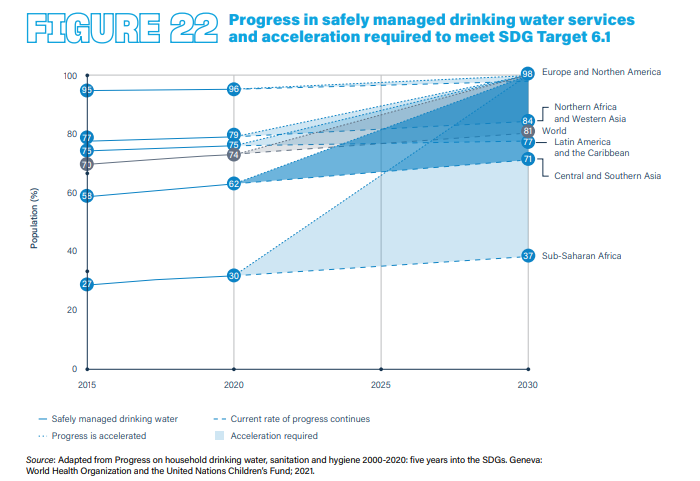

Acknowledgements
This report is the result of collaboration between a large number of contributors, reviewers and editors. The development of the report was led by Jennifer de France (Team Leader, Drinking-water Quality and Safety, WHO) in coordination with Jorge Alvarez-Sala (Senior Advisor for Water and Climate Resilient Water, Sanitation and Hygiene (WASH) a.i., UNICEF) and Chloe Viola (Senior Water Supply and Sanitation Specialist, World Bank). It was developed under the overall direction and guidance of Bruce Gordon (Coordinator of Water, Sanitation, Hygiene and Health, WHO) and Kelly Ann Naylor (Director, Water, Sanitation, Hygiene (WASH) & Climate, Environment, Energy, and Disaster Risk Reduction (CEED), UNICEF). Thanks are due to Jennifer Sara and Saroj Jha (former and current Global Director for the Water Global Practice at the World Bank, respectively) for contributing to and supporting the conception of this report. Clarissa Brocklehurst acted as lead writer and managing editor and Simon Mead as editor.
This document benefited from the valuable contributions of Betsy Engebretson, Fiona Gore, Rick Johnston, Batsirai Majuru and Angella Rinehold at WHO; Tom Slaymaker at UNICEF and Joel Kolker and Gustavo Saltiel at the World Bank.
The authors are grateful to the many others who assisted with contributions and review including Ashanti Bleich, Joanna Esteves Mills, Mark Hoeke, Rory McKeown, Oliver Schmoll and Nghia Ton at WHO; Jose Gesti Canuto, Guy Hutton and Nicolas Osbert at UNICEF; Sarah Keener and Si Gou from the World Bank’s Water Global Practice; Zehra Shabbir and Rich Thorsten at Water.org; Tara Bartnik, Vincent Casey, Md Khairul Islam, Md Tahmidul Islam and Hasin Jahan at WaterAid; Marieke Adank, Juste Nansi and Stef Smits at IRC; Karl Linden at the University of Colorado Boulder; Rob Hope at the University of Oxford; Guy Howard at the University of Bristol; and Harold Lockwood and Bill Twyman at Aguaconsult.
Suggested citation.
WHO, UNICEF, World Bank. State of the world’s drinking water: an urgent call to action to accelerate progress on ensuring safe drinking water for all. Geneva: World Health Organization; 2022. Licence: CC BY-NC-SA 3.0 IGO.
Names mentioned
Dr Maria Neira, WHO Director, Department of Environment, Climate Change and Health.
Saroj Kumar Jha, Director, Global Director, World Bank Group’s Water Global Practice.
Aidan Cronin, UNICEF Interim Director of Water, Sanitation, and Hygiene (WASH) and Climate, Environment, Energy, and Disaster Risk Reduction (CEED).
DR. TEDROS ADHANOM GHEBREYESUS
irector-General World Health Organization
DR. JUERGEN VOEGELE
Vice President of Sustainable Development World Bank
MS. CATHERINE RUSSELL
Executive Director UNICEF
Sara Alhattab, UNICEF New York,
Meriem Grey, World Bank,




